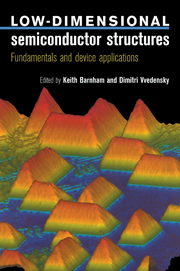Book contents
- Frontmatter
- Contents
- List of contributors
- Preface
- 1 Epitaxial Growth of Semiconductors
- 2 Electrons in Quantum Semiconductor Structures: An Introduction
- 3 Electrons in Quantum Semiconductors Structures: More Advanced Systems and Methods
- 4 Phonons in Low-dimensional Semiconductor Structures
- 5 Localization and Quantum Transport
- 6 Electronic States and Optical Properties of Quantum Wells
- 7 Non-Linear Optics in Low-dimensional Semiconductors
- 8 Semiconductor Lasers
- 9 Mesoscopic Devices
- 10 High-speed Heterostructure Devices
- Solutions to Selected Exercises
- Index
10 - High-speed Heterostructure Devices
Published online by Cambridge University Press: 06 July 2010
- Frontmatter
- Contents
- List of contributors
- Preface
- 1 Epitaxial Growth of Semiconductors
- 2 Electrons in Quantum Semiconductor Structures: An Introduction
- 3 Electrons in Quantum Semiconductors Structures: More Advanced Systems and Methods
- 4 Phonons in Low-dimensional Semiconductor Structures
- 5 Localization and Quantum Transport
- 6 Electronic States and Optical Properties of Quantum Wells
- 7 Non-Linear Optics in Low-dimensional Semiconductors
- 8 Semiconductor Lasers
- 9 Mesoscopic Devices
- 10 High-speed Heterostructure Devices
- Solutions to Selected Exercises
- Index
Summary
Introduction
High-speed semiconductor devices are key elements in the development of electronic systems for data processing or analogue signal handling at ever-higher frequencies (the state-of-the-art is currently in excess of 100 GHz; a detailed discussion of a wide range of devices is given by Sze (1990)). Most of these systems use circuits based on Si devices prepared by implantation or diffusion, but these fabrication processes are limited in their ability to produce the small-scale device structures required for high-speed operation. However, the advent of highly controllable epitaxial deposition processes such as molecular-beam epitaxy (MBE) and metal-organic vapour-phase epitaxy (MOVPE) has enabled semiconductor structures to be prepared with compositional or dopant properties defined in layers with thicknesses down to the atomic scale. In many cases, this results in the mobile charge carriers being confined in a quasi-two-dimensional sheet, giving rise to a wide range of quantum confinement effects, as described in the earlier chapters of this book. Historically, these heterostructures have been prepared in III–V compound semiconductors, principally GaAs and (Al,Ga)As, although recently much effort is being put into investigating epitaxial Si and SiGe layers. This chapter will review two classes of electronic device, namely those involving transport of charge along the two-dimensional sheets, based on variations on the field-effect transistor (FET) principle, and those using ‘vertical’ transport, i.e. perpendicular to the sheets. It is interesting to note that, with the exception of resonant tunnelling and superlattice structures, the performance characteristics of these devices are not primarily due to quantum confinement effects associated with their two-dimensional nature, although these may play a secondary role in some instances.
- Type
- Chapter
- Information
- Low-Dimensional Semiconductor StructuresFundamentals and Device Applications, pp. 348 - 378Publisher: Cambridge University PressPrint publication year: 2001



